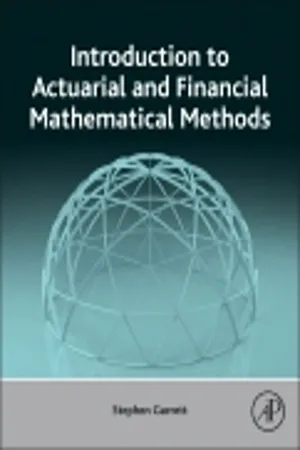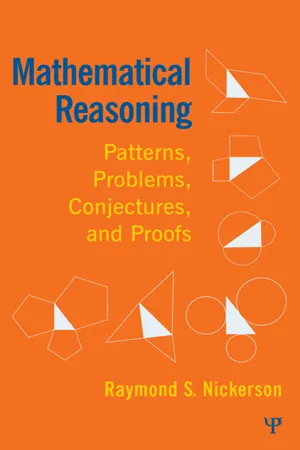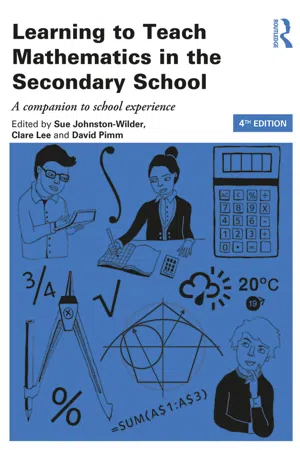Mathematics
Notation
Notation in mathematics refers to the symbols, characters, and conventions used to represent mathematical concepts, operations, and relationships. It provides a standardized way to express mathematical ideas and facilitates communication and understanding among mathematicians and students. Notation can vary across different branches of mathematics and may evolve over time to accommodate new discoveries and developments.
Written by Perlego with AI-assistance
Related key terms
Related key terms
1 of 4
Related key terms
1 of 3
3 Key excerpts on "Notation"
- Stephen Garrett(Author)
- 2015(Publication Date)
- Academic Press(Publisher)
Chapter 1Mathematical Language
Abstract
In this chapter, we state and illustrate the use of common mathematical Notation that will be used without further comment throughout this book. It is assumed that much of this section will have been familiar to you at some point of your education and is included as an aide-mémoire . Of course, given that the book will explore many areas of the application of mathematics, the material presented here may well prove to be incomplete. It should therefore be considered as an illustration of the level of mathematics that will be assumed as prerequisite, rather than a definitive list.Keywords Number systems Mathematical symbols Set Notation Interval Notation Quantifiers Equations Identities InequalitiesContents1.1 Common Mathematical Notation 31.1.1 Number systems 31.1.2 Mathematical symbols 61.2 More Advanced Notation 81.2.1 Set Notation 81.2.2 Interval Notation 121.2.3 Quantifiers and statements 131.3 Algebraic Expressions 141.3.1 Equations and identities 141.3.2 An introduction to mathematics on your computer 171.3.3 Inequalities 181.4 Questions 20Prerequisite knowledge Learning objectives • “School” mathematics• use of a calculator• algebraic manipulation• analytical solution of simple polynomial expressions• Familiarity with basic use of Excel• Define, recognize, and use• number systems• mathematical Notation including set Notation• bracket Notation• quantifiers• equations, identities, and inequalitiesIn this chapter, we state and illustrate the use of common mathematical Notation that will be used without further comment throughout this book. It is assumed that much of this section will have been familiar to you at some point of your education and is included as an aide-mémoire- eBook - ePub
Mathematical Reasoning
Patterns, Problems, Conjectures, and Proofs
- Raymond Nickerson(Author)
- 2011(Publication Date)
- Psychology Press(Publisher)
The introduction of new Notational conventions has provided significant economies of expression and greatly facilitated the performance of mathematical operations. And the Notational systems invented to represent new mathematical ideas have stimulated and made possible further advances in mathematical thinking. So central are representations to mathematics that, according to one view, “mathematics can be said to be about levels of representation, which build on one another as the mathematical ideas become more abstract” (Kilpatrick, Swafford, & Findell, 2001, p. 19). Mathematicians who have developed new areas of mathematics have often found it essential to invent new Notational schemes in order to make progress. Diophantus, Descartes, Euler, and Leibniz are all remembered for their original contributions to mathematics; each of them also introduced new Notational conventions and did so because the existing ones were not adequate to represent the thinking they wished to do. Jourdain (1913/1956) claims that Leibniz, who is remembered for numerous contributions to philosophy, science, and mathematics, attributed all his mathematical discoveries to his improvements in Notation. As discussed in Chapter 4, mathematical ideas have progressed from the more concrete to the more abstract. The emergence of new Notational conventions often has been forced by the need to represent a new level of abstraction. This progression is illustrated by the symbols 3, x, and f(x), which represent the increasingly abstract ideas of number, variable, and function. The concept three, as distinct from three stones or three sheep, is an abstraction; threeness is the property that three sheep and three stones have in common. The concept number is a further abstraction; numberness is what 3, 17, and 64 have in common - eBook - ePub
Learning to Teach Mathematics in the Secondary School
A companion to school experience
- Sue Johnston-Wilder, Clare Lee, David Pimm, Sue Johnston-Wilder, Clare Lee, David Pimm(Authors)
- 2016(Publication Date)
- Routledge(Publisher)
ys as a major source of mystification. In some cases, the introduction of algebraic Notation early in the secondary school is felt to have been the turning point at which an otherwise academically successful student started to fail in mathematics. To many people, symbols appear to have little meaning, while attempting to work with them may be a frustrating and anxiety-inducing task.At the same time, however, algebraic symbolism is enormously important in mathematics, not only as a means of expressing generalisations, but also as a means of thinking about and manipulating problems that might otherwise prove intractable. It is, therefore, important to help students to develop meaning for symbols and to see them as useful means of communicating mathematical ideas.One way of demystifying symbolism is to introduce it as a natural development of students’ own attempts to record their generalisations of patterns. James and Mason (1982) described the process by which some children’s verbal explanations of how to build square ‘picture frames’ out of interlocking cubes were converted, via the introduction of a ‘thinks cloud’ standing for the variable size of the picture, into a more conventional algebraic expression (Figure 8.3 ).The teacher’s role is crucial here in introducing appropriate forms of Notation at a time when the students can appreciate a need for them. Through having struggled to produce their own means of recording and having to interpret others’ attempts, students are more likely to see the usefulness of a standard Notation. In this case, an obvious further benefit that the students would be able to see is the possibility of comparing different ways of building the picture frames through the use of a common descriptive Notation. Such an introduction, building on students’ own patterning and generalising, should enable students to attach meaning to algebraic symbols and to see them as a useful addition to their repertoire of means of communicating mathematical ideas. Computer environments that are controlled by students’ own use of algebraic Notation can provide a particularly powerful context for making sense of symbolism. Dave Hewitt (2014) gives an account of such sense-making using the softwareGrid Algebra
Index pages curate the most relevant extracts from our library of academic textbooks. They’ve been created using an in-house natural language model (NLM), each adding context and meaning to key research topics.
Explore more topic indexes
Explore more topic indexes
1 of 6
Explore more topic indexes
1 of 4


